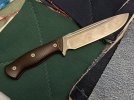-
The BladeForums.com 2024 Traditional Knife is ready to order! See this thread for details: https://www.bladeforums.com/threads/bladeforums-2024-traditional-knife.2003187/
Price is$300$250 ea (shipped within CONUS). If you live outside the US, I will contact you after your order for extra shipping charges.
Order here: https://www.bladeforums.com/help/2024-traditional/ - Order as many as you like, we have plenty.
You are using an out of date browser. It may not display this or other websites correctly.
You should upgrade or use an alternative browser.
You should upgrade or use an alternative browser.
Fullrs: Not many knives with fullers out there.
- Thread starter VorpelSword
- Start date
ferider
Platinum Member
- Joined
- Jun 20, 2018
- Messages
- 15,067
Those fullers are both milled. The upper example is the type of fuller I like the least. "hey guys, we bought a mill". A flat straight slot with round ends the shape of the cutter. The CPK is also milled, but has plunges at the ends and isn't flat along the groove. My favorites are like the Jason Knight example where it's very organic, curved along its length and varying in depth and width.
Was really impressed how


Nathan the Machinist
KnifeMaker / Machinist / Evil Genius
Moderator
Knifemaker / Craftsman / Service Provider
- Joined
- Feb 13, 2007
- Messages
- 18,101
Fullers have been a design element in blades for a very long time originating when steel was forged to shape.
You're not going to increase the stiffness or strength of a section by removing material from it. But you most certainly can increase the stiffness and strength of a section by redistributing material away from the center line, increasing the area moment of inertia of the cross section. Which basically means, more stuff farther away from the neutral axis of a bend. This gives you your sectional modulus which dictates the relative stiffness of a section. A fuller, used correctly, is about optimizing the location of the material being used.
When making long pokey things out of bronze and iron, it didn't take smith's very long to notice that you can smoosh some metal down in the center of the blade and upset material up around it, increasing the thickness, resulting in a stiffer stronger blade for the same amount of material (and weight.)
You're not going to be making anything stiffer by compacting material. We're not working with material that has foamy voids in it, the stiffness of the steel is baked in. For all practical purposes, the stiffness of steel doesn't really vary much at all, but that's another discussion.
Adding a fuller to a knife does not make that knife stiffer or stronger. Using a fuller as an element in the design can absolutely make a knife stiffer or stronger. The same rules about material distribution apply whether the knife is machined or forged. You can include a fuller in your design and get a wider blade or a thicker blade for the same amount of weight, if used in an intelligent manner. It's one of the tools in your kit when designing a blade. When balancing a knife, it is one of the tools a knife designer can use.
Personally, I can be a bit of an insufferable knife design snob and I sometimes unintentionally offend people when talking about other people's work.
That said, here we go. (Apologies to all who I may offend here)
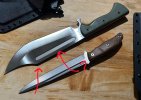
What is the purpose of this large chunk of metal here on the spine. Why is that there?
A reasonable answer: to add mass to the blade to make it a more powerful chopper
Why is this fuller here what is it doing? A reasonable answer: to reduce mass in the blade to reduce unnecessary weight or improved balance.
To me, this design is like an air conditioning inside your oven. These two elements are working against each other. Why are they like this? What was the thought process behind the material distribution in this blade?
I'll try to quit being insufferable now. Sorry about that.
I understand that a fuller is an attractive design element added to pieces for its visual value. Nothing wrong with that. Ferraris are intentionally beautiful and that beauty and the design choices don't always only have something to do with going fast. However, race cars and jet aircraft are also often beautiful, and the design elements that make them beautiful we're not chosen because they were beautiful, but because they work and they're fast. And that is beautiful. The SR-71 being a favorite example.
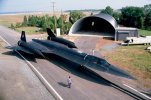
Man I really like that. What a beautiful aircraft. And I think it's unlikely there are any significant design choices made in that aircraft that were made for aesthetic purposes. That's pure engineering yet it looks amazing doesn't it? I think it does *shrug*.
Fullers are often a component of swords and stabbing weapons, and these things tend to be sleek and stabby, which can be very beautiful. An amazing example of form following function, meaning shape derived from functional needs.
You're going to see fullers on tactical weapons because historical weapons had fullers. Some are functional, some are purely aesthetic. There's nothing really wrong with doing something purely for aesthetics but personally I gain more satisfaction from an object if everything about it serves a purpose and it happens to be beautiful, rather than something that is artistically beautiful but contrived and functionally pointless. Worse, is when a design choice is made for aesthetics and it actually works against the function.
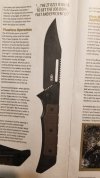
^ Like this stupid shit right here. What on earth are they thinking? Why would they do that? The holes in the plunge. Like a perforated postage stamp. I keep this picture in my phone as an example of one of the dumbest design choice I think I've ever seen put into production. It's an aesthetic choice that will directly contribute to that blade's failure. Why?
Some fullers might be removing weight in a way that could be removed more effectively with a different design choice. Or it might be removing weight from an object that does not benefit from the removal of that weight in that location. And frequently, you will see a small decorative fuller that is shallow and narrow which doesn't remove any significant weight at all, but could contribute to either weakness or detract from the ability of the blade to cut due to its location and potential to drag.
To summarize, a functional fuller is an important design element that can be used to optimize the weight, strength and balance of some knives that benefit from it. It is also a pretty cool aesthetic design element that I really enjoy. They can be well executed or they can be tragic.
Edit: I should write a lengthy diatribe about the misapplication of tapered tangs next lol...
You're not going to increase the stiffness or strength of a section by removing material from it. But you most certainly can increase the stiffness and strength of a section by redistributing material away from the center line, increasing the area moment of inertia of the cross section. Which basically means, more stuff farther away from the neutral axis of a bend. This gives you your sectional modulus which dictates the relative stiffness of a section. A fuller, used correctly, is about optimizing the location of the material being used.
When making long pokey things out of bronze and iron, it didn't take smith's very long to notice that you can smoosh some metal down in the center of the blade and upset material up around it, increasing the thickness, resulting in a stiffer stronger blade for the same amount of material (and weight.)
You're not going to be making anything stiffer by compacting material. We're not working with material that has foamy voids in it, the stiffness of the steel is baked in. For all practical purposes, the stiffness of steel doesn't really vary much at all, but that's another discussion.
Adding a fuller to a knife does not make that knife stiffer or stronger. Using a fuller as an element in the design can absolutely make a knife stiffer or stronger. The same rules about material distribution apply whether the knife is machined or forged. You can include a fuller in your design and get a wider blade or a thicker blade for the same amount of weight, if used in an intelligent manner. It's one of the tools in your kit when designing a blade. When balancing a knife, it is one of the tools a knife designer can use.
Personally, I can be a bit of an insufferable knife design snob and I sometimes unintentionally offend people when talking about other people's work.
That said, here we go. (Apologies to all who I may offend here)

What is the purpose of this large chunk of metal here on the spine. Why is that there?
A reasonable answer: to add mass to the blade to make it a more powerful chopper
Why is this fuller here what is it doing? A reasonable answer: to reduce mass in the blade to reduce unnecessary weight or improved balance.
To me, this design is like an air conditioning inside your oven. These two elements are working against each other. Why are they like this? What was the thought process behind the material distribution in this blade?
I'll try to quit being insufferable now. Sorry about that.
I understand that a fuller is an attractive design element added to pieces for its visual value. Nothing wrong with that. Ferraris are intentionally beautiful and that beauty and the design choices don't always only have something to do with going fast. However, race cars and jet aircraft are also often beautiful, and the design elements that make them beautiful we're not chosen because they were beautiful, but because they work and they're fast. And that is beautiful. The SR-71 being a favorite example.

Man I really like that. What a beautiful aircraft. And I think it's unlikely there are any significant design choices made in that aircraft that were made for aesthetic purposes. That's pure engineering yet it looks amazing doesn't it? I think it does *shrug*.
Fullers are often a component of swords and stabbing weapons, and these things tend to be sleek and stabby, which can be very beautiful. An amazing example of form following function, meaning shape derived from functional needs.
You're going to see fullers on tactical weapons because historical weapons had fullers. Some are functional, some are purely aesthetic. There's nothing really wrong with doing something purely for aesthetics but personally I gain more satisfaction from an object if everything about it serves a purpose and it happens to be beautiful, rather than something that is artistically beautiful but contrived and functionally pointless. Worse, is when a design choice is made for aesthetics and it actually works against the function.

^ Like this stupid shit right here. What on earth are they thinking? Why would they do that? The holes in the plunge. Like a perforated postage stamp. I keep this picture in my phone as an example of one of the dumbest design choice I think I've ever seen put into production. It's an aesthetic choice that will directly contribute to that blade's failure. Why?
Some fullers might be removing weight in a way that could be removed more effectively with a different design choice. Or it might be removing weight from an object that does not benefit from the removal of that weight in that location. And frequently, you will see a small decorative fuller that is shallow and narrow which doesn't remove any significant weight at all, but could contribute to either weakness or detract from the ability of the blade to cut due to its location and potential to drag.
To summarize, a functional fuller is an important design element that can be used to optimize the weight, strength and balance of some knives that benefit from it. It is also a pretty cool aesthetic design element that I really enjoy. They can be well executed or they can be tragic.
Edit: I should write a lengthy diatribe about the misapplication of tapered tangs next lol...
Last edited:
ferider
Platinum Member
- Joined
- Jun 20, 2018
- Messages
- 15,067
View attachment 2677769
What is the purpose of this large chunk of metal here on the spine. Why is that there?
Thanks for posting Nathan ! Hard to see in the pic: the fuller in the WTG is very shallow, 100% decorative and I assume an homage to the original V44 (Marine Raider bowie) that Reese commemorates with this knife.
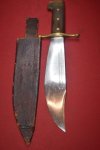
Not offended at all, in case you wonder
Last edited:
VorpelSword
Gold Member
- Joined
- Dec 27, 2007
- Messages
- 1,635
Lots of ineresting big knives out there today. When I was a Boy Scout in the 1960s, most sheath knives looked like a miniature Bowe.
I am probably mistaken here, but it is my impression that none of the current issue knives for US forces have a fuller.
"Course, the USMC has dropped bayonet usage in favor of universal suppressors. Just prior to that, they had adopted a bayonet from Ontario that was larger than the Army issue.
I am probably mistaken here, but it is my impression that none of the current issue knives for US forces have a fuller.
"Course, the USMC has dropped bayonet usage in favor of universal suppressors. Just prior to that, they had adopted a bayonet from Ontario that was larger than the Army issue.
Again, read post #25 in this thread, and read the link. Those are written by the experts who actually can tell you what fullers are for on a knife blade. They started as a functional design element with the hugely successful Marbles Ideal knife in 1898. The people who copied the knife had no idea what they were for, so they just made blades with grooves in them because it was a popular selling point.I think they were invented for weight reduction in large blades without significantly compromising durability.
The first 1919C2 was created in the style of a commercial hunting knife that was produced by the Union Cutlery Company. And the Union Cutlery Company took their idea from a wildly successful “Ideal” hunting knife made by the Marbles Company. The Marbles knife had fullers that were quite wide and deep and were positioned lower on the blade. This ingenious design allowed the Marbles knife to be successfully flat-sharpened (by holding the blade flat) on a flat stone while in the field.
J. Doyle
Knifemaker / Craftsman / Service Provider
- Joined
- Feb 17, 2008
- Messages
- 8,266
There were fullers in blades long before marbles and they had nothing to do with sharpening.Again, read post #25 in this thread, and read the link. Those are written by the experts who actually can tell you what fullers are for on a knife blade. They started as a functional design element with the hugely successful Marbles Ideal knife in 1898. The people who copied the knife had no idea what they were for, so they just made blades with grooves in them because it was a popular selling point.
Read the post from
DocJD
Basic Member
- Joined
- Jan 29, 2016
- Messages
- 12,080
Fuller ...and handy banana holder !
Reread my post.....There were fullers in blades long before marbles and they had nothing to do with sharpening.
Read the post fromNathan the Machinist above.
Swords and similar long blades had fullers for centuries.
Knives and smaller blades didn't until the beginning of the 20th century after the Ideal was introduced. Every modern so called tactical knife or military knife with those ridiculous "blood grooves" had its beginnings with Webster Marble despite what the current knife snobs might say.....
A lot of historical Kukries had fullers for weight reduction and balance adjustment as well as looks. A lot of the better modern ones still do.
I imagine in an OTF blade it makes the blade lighter and positively effects the action.
Even I can figure that fullers can be used for blade balance on knives of many sizes.
Just because some mall ninja companies hijacked the design for looks does not make it useless.
So you see fullers are a lot more than just mere fudd busters.
I imagine in an OTF blade it makes the blade lighter and positively effects the action.
Even I can figure that fullers can be used for blade balance on knives of many sizes.
Just because some mall ninja companies hijacked the design for looks does not make it useless.
So you see fullers are a lot more than just mere fudd busters.
Last edited:
J. Doyle
Knifemaker / Craftsman / Service Provider
- Joined
- Feb 17, 2008
- Messages
- 8,266
Hard pass.Reread my post.....
- Joined
- Oct 18, 2018
- Messages
- 8,326
Oh my. I'm forrest gump on the bed with Jenny
I never saw the movie...... I have NO idea what you are talking about, but You should work in Marketing.....I like how you paint a picture, and I'm wondering If I should see this? Ha!
- Joined
- Jul 23, 2015
- Messages
- 17,826
The idea that a fuller is a "blood groove" is 80's movie nonsense. Cost is increased from machining and finishing a fuller groove and it adds no real appreciable benefit, maybe some weight savings. The old argument that it was like an I beam and increased the blades strength is also false, or at least not significantly measurable in a knife. On swords the fuller was done to save weight.
I do agree they look cool. I have done a few smaller blades with fullers, just because. Ben Tendick (@BenR.T. ) is the master of the fuller in my opinion.
On something short-bladed like a knife, a fuller is mostly for aesthetics. I'm not saying it doesn't affect balance or weight at all, but it's probably negligible and often unnoticeable.
Most of the knives they're on it was done because "it looks cool".
I don't think, and I could be wrong, but I don't think that removing material in any way shape or form makes anything stronger. Like an I beam, they remove material and shape it to maintain rigidity and load bearing capabilities but it's not actually stronger than a solid piece. It is more efficient in terms of strength to weight ratio in some cases though.
First, by putting in the fuller through forging, you're displacing that metal elsewhere -- and very likely making it thicker in (right-to-left) cross section elsewhere. This could make it stiffer, at least in that one plane. Second, the act of forging aligns the "grain" of the steel at a microscopic level to some degree, making it stiffer -- especially after quenching...
I can see how compacting the steel would make it denser and therefore more difficult to bend. I'm a machinist/cnc programmer by trade, we remove material for a variety of reasons and I have a good understanding of metal working but not forging.
I'd love to get educated on forging and how it changes the structure!
Welp, I collected all these quotes while reading the thread for nothing. Thanks
- Joined
- Oct 18, 2018
- Messages
- 8,326
Those fullers are both milled. The upper example is the type of fuller I like the least. "hey guys, we bought a mill". A flat straight slot with round ends the shape of the cutter. The CPK is also milled, but has plunges at the ends and isn't flat along the groove. My favorites are like the Jason Knight example where it's very organic, curved along its length and varying in depth and width.
Just admit you think Nathan is secretly a Ninja.
A structural engineer will tell you that this is completely correct. Well one slight correction- area moment of inertia provides a measure of the bending stiffness of a section, section modulus provides a measure of the bending strength of a section.You're not going to increase the stiffness or strength of a section by removing material from it. But you most certainly can increase the stiffness and strength of a section by redistributing material away from the center line, increasing the area moment of inertia of the cross section. Which basically means, more stuff farther away from the neutral axis of a bend. This gives you your sectional modulus which dictates the relative stiffness of a section
Regarding fluted rifle barrels- adding flutes will lighten the barrel and it will change the vibration characteristics, but removing material to make flutes will not make the barrel stiffer. The alternative method for lightening the barrel is to just put it in a lathe and make the whole thing smaller diameter. A barrel with flutes that weighs the same amount as a round smooth barrel without flutes will be stiffer because the fluted barrel overall is slightly larger diameter and read the above quoted text- "can increase the stiffness ... by redistributing material away from the center line".
SharpBits
Gold Member
- Joined
- Apr 26, 2002
- Messages
- 5,586
Thank you for the part about barrel flutes. It answers long standing questions I’ve had and it shows how the misunderstanding happened.A structural engineer will tell you that this is completely correct. Well one slight correction- area moment of inertia provides a measure of the bending stiffness of a section, section modulus provides a measure of the bending strength of a section.
Regarding fluted rifle barrels- adding flutes will lighten the barrel and it will change the vibration characteristics, but removing material to make flutes will not make the barrel stiffer. The alternative method for lightening the barrel is to just put it in a lathe and make the whole thing smaller diameter. A barrel with flutes that weighs the same amount as a round smooth barrel without flutes will be stiffer because the fluted barrel overall is slightly larger diameter and read the above quoted text- "can increase the stiffness ... by redistributing material away from the center line".





